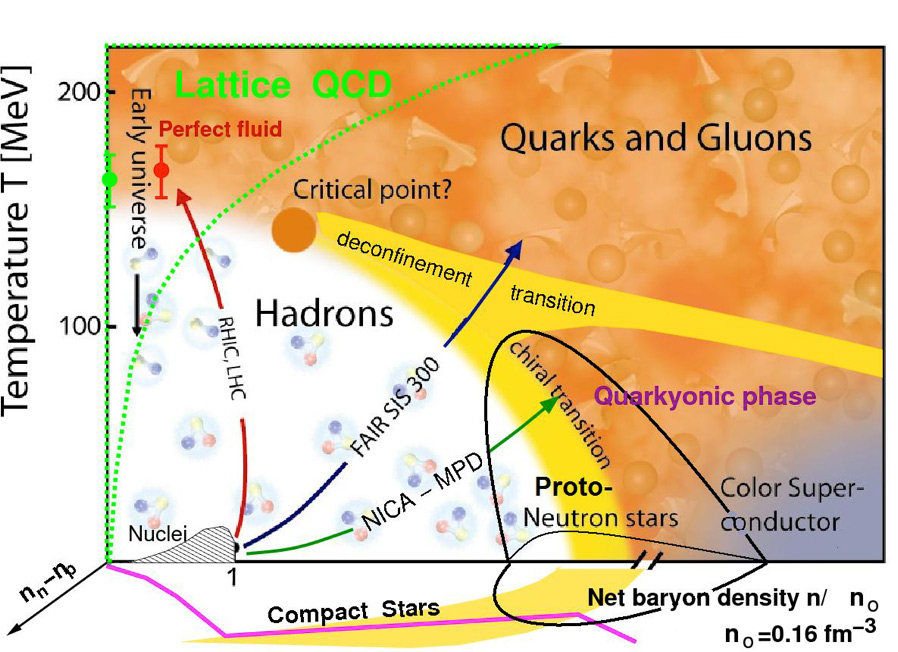M. Chartier, J. Dainton, R. Lemmon, M. Figueredo, R. Romita, S. Gannon, J. Norman, W. Powell
Our modern understanding of matter is based at its most fundamental level on the Standard Model (SM), which describes the elementary particles as well as the strong, weak and electromagnetic interactions between these particles. The recent discovery at the LHC of the Higgs boson, and the resulting evidence which it brings for the existence of the necessary scalar fields in the SM, marks the culmination of a remarkable half-century of experimental investigation and scientific progress. We now understand the fundamental quanta of presently visible matter in the Universe. However, as the basis for our present understanding of the fundamental nature of matter, the SM should also provide a complete description of its bulk properties, even under extreme conditions of temperature and density. In other words, it should be capable of describing the thermodynamics and phase equilibria of such matter if we are to claim that the SM is our correct description of reality. Such thermodynamic understanding is pivotal for cosmology and astrophysics.

Figure: Phase diagram of nuclear matter showing temperature and density dependence as well as neutron-proton asymmetry.
To date, the Universe is believed to have evolved through two phase transitions. Around 10-12 s after the singularity, the electroweak (EW) phase transition occurred at temperatures of O(100) GeV, and massive quanta, fermions (quarks and leptons) and bosons (W and Z), appeared by means of the Higgs-mechanism and spontaneous symmetry breakdown. At much lower temperatures of O(100) MeV, and accordingly at a correspondingly later epoch, around 10-5 s, hadronic condensation followed in which the non-Abelian confinement of quantum chromodynamics (QCD) is presently understood to have governed the evolution of matter into the colour-singlet baryons and mesons in terms of which we understand today the visible mass of the Universe and also the total breakdown of chirality in Nature. In principle, further phase transitions at even earlier times and correspondingly higher temperatures are possible. Such is the physics at “the energy frontier” pursued by the General Purpose Detectors (GPDs) ATLAS and CMS at the LHC.
In the present epoch of the Universe, densities can be reached in the core of neutron stars which may be sufficient to induce a QCD phase transition to deconfined quark matter. It is now experimentally possible to create bulk matter at temperatures of O(100) MeV in the laboratory by means of heavy-ion collisions. It is thereby feasible to measure the properties of such strongly interacting matter and to attempt to understand these properties in terms of QCD-thermodynamics. Measurements which cover a wide range of present and foreseeable collision energies with different ion species make possible systematic and comprehensive studies of the chromodynamic phase diagram. As well as it being possible so to anticipate huge progress in our understanding of chromodynamics in hadronic physics, such opportunities also provide a new and unique “laboratory” for non-abelian gauge-theory field dynamics, much as Nuclear Structure has for more than 70 years provided a laboratory for many-body, nucleon, physics.
Our research programme is focused on two regions of the phase diagram:
i. Partonic Matter at High Temperatures (ALICE):
Understanding the properties of partonic matter at high temperatures and vanishing net baryon densities via heavy flavour probes.
ii. Hadronic Matter at High Densities (GSI/FAIR, RIKEN):
Hadronic matter at high net baryon densities and moderate temperatures, and in particular the influence of the isospin degree of freedom on the hadronic equation of state.
For both parts of our programme a wide range of ion-ion (AA) collision energies is necessary, together with pp and pA data at the same energies. The above work of the group is of necessity carried out with international collaborators using assemblies of distinctive detectors in experiments which are able to measure simultaneously the dynamics of hadronic flavour and colour in ion-ion interactions.